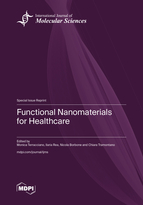Functional Nanomaterials for Healthcare
A special issue of International Journal of Molecular Sciences (ISSN 1422-0067). This special issue belongs to the section "Materials Science".
Deadline for manuscript submissions: closed (28 February 2023) | Viewed by 74643
Special Issue Editors
Interests: surface functionalization chemistry; nanostructured materials; hybrid materials; chemical characterization; diagnostics; drug delivery
Special Issues, Collections and Topics in MDPI journals
Interests: nanomaterials; hybrid interfaces; photoluminescence; optical biosensors; drug delivery systems
Special Issues, Collections and Topics in MDPI journals
Interests: nucleic acid chemistry and biology; DNA quadruplexes formed by telomers, aptamers, and synthetic G-rich oligonucleotides; chemical-physical characterization of soft interfaces; hybrid interfaces; therapeutics; diagnostics
Special Issues, Collections and Topics in MDPI journals
Department of Pharmacy, University of Naples Federico II, Via Domenico Montesano 49, 80131 Naples, Italy
Interests: hybrid materials; colorectal cancer; nanoparticles; drug delivery; active targeting; small molecules
Special Issue Information
Dear Colleagues,
In recent decades, a great effort has been dedicated to the synthesis and surface functionalization of functional nanomaterials for healthcare. This genuine interest has been nourished by the unique properties that nanomaterials offer over bulk materials, such as surface-to-volume ratio, high porosity, and easy tunability of their physicochemical properties. Among the wide array of nanomaterials available for medical applications, nanoparticles (NPs), nanotubes (NTs), nanorods (NRs), and nanofilms (NFs) are having a revolutionary impact on healthcare, offering precise and personalized treatments. Functionalization of nanomaterials involves altering their chemical and physical properties to achieve non-invasive imaging, controlled delivery of therapeutic compounds, and tissue engineering purposes. Furthermore, based on their ability to combine diagnostic and therapeutic compounds, functionalized nanomaterials also hold great promise for theranostic purposes.
The present Special Issue is suited for contributions on functional nanomaterials for drug delivery, bioimaging, diagnosis, theranostics, and tissue engineering. Different synthesis and functionalization procedures, characterization techniques, and medical applications of nanomaterials will be covered, and novel insights can be proposed. Thus, we are delighted to invite you to submit a full paper, letter, communication, review, or perspective article to this Special Issue.
Dr. Monica Terracciano
Dr. Ilaria Rea
Prof. Nicola Borbone
Dr. Chiara Tramontano
Guest Editors
Manuscript Submission Information
Manuscripts should be submitted online at www.mdpi.com by registering and logging in to this website. Once you are registered, click here to go to the submission form. Manuscripts can be submitted until the deadline. All submissions that pass pre-check are peer-reviewed. Accepted papers will be published continuously in the journal (as soon as accepted) and will be listed together on the special issue website. Research articles, review articles as well as short communications are invited. For planned papers, a title and short abstract (about 100 words) can be sent to the Editorial Office for announcement on this website.
Submitted manuscripts should not have been published previously, nor be under consideration for publication elsewhere (except conference proceedings papers). All manuscripts are thoroughly refereed through a single-blind peer-review process. A guide for authors and other relevant information for submission of manuscripts is available on the Instructions for Authors page. International Journal of Molecular Sciences is an international peer-reviewed open access semimonthly journal published by MDPI.
Please visit the Instructions for Authors page before submitting a manuscript. There is an Article Processing Charge (APC) for publication in this open access journal. For details about the APC please see here. Submitted papers should be well formatted and use good English. Authors may use MDPI's English editing service prior to publication or during author revisions.
Keywords
- nanoparticles
- nanostructured materials
- porous materials
- hybrid materials
- synthesis
- surface functionalization of nanostructures
- nanobiotechnology
- nanomedicine
- cancer therapy
- diagnostics
- drug delivery
- bioimaging
- theranostics
- tissue engineering
- biocompatibility










